Are you looking to purchase a new motorcycle helmet? If so, you may be wondering if the Shoei RF-1100 is a good option. We will provide a guide, including answers to some of the most common questions. We’ll also offer some useful tips to help you decide if this helmet is right for your needs.
Table of Contents
Shoei RF-1100 Helmet Overview
 The Shoei RF-1100 is a popular choice for motorcycle riders. It offers great protection and is comfortable to wear. The helmet is available in a variety of sizes, so you can find one that fits you well. You can also choose from several different colors, including black, white, and silver.
The Shoei RF-1100 is a popular choice for motorcycle riders. It offers great protection and is comfortable to wear. The helmet is available in a variety of sizes, so you can find one that fits you well. You can also choose from several different colors, including black, white, and silver.One of the best things about it is that it’s very lightweight. It only weighs about three pounds, so you won’t get tired of wearing it after a long day on the road. The helmet also has good ventilation, so you’ll stay cool even on hot days.
Interior System
- Ergonomically designed
- Breath guard
Eyeglass compatible - Weight 3.9 lbs / 1770 g
- DOT and Snell M2015 approved
Shoei RF-1100 Helmet Size Chart

Buyer’s Guide
Types of Motorcycle Helmets
It’s important to know that there are three main types. Each type has its benefits and drawbacks.
Full-Face Helmet
This type offers the most protection, covering the entire head, including your chin and face. This type of helmet is a good choice if you do a lot of highway riding or if you’re worried about safety.
The downside of it is that it can be hot to wear, especially in the summer.
You want one that fits snugly but isn’t too tight. And be sure to test the visor to make sure it doesn’t fog up.
Modular
It has a hinge in the front. This allows you to flip up the visor and chin guard.
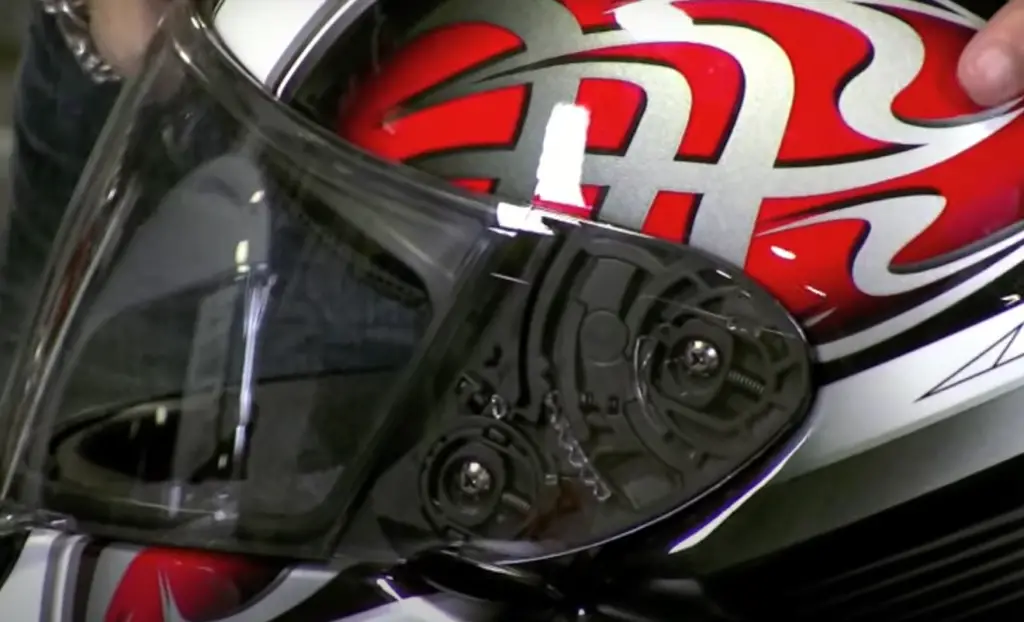
Modular helmets offer some advantages. One of the big advantages is that they’re much easier to put on and remove. And if you wear glasses, it’s easy to flip up the visor and put them on without taking the entire helmet off.
The downside is that they have less protection.
Open-Face
It is also called a 3/4 helmet, covering the head and ears but not your chin or face. It offers less protection, but it’s more comfortable in hot weather.
Be sure to get one with a good visor. You’ll need one that’s large enough to shield your eyes from the sun and insects. And make sure the visor doesn’t fog up.
Half-Face
It is also called a half shell. As you might guess from the name, it covers only half of the face. This type is the lightest and coolest, making it a good choice for summer riding.
The downside is that it offers the least protection. If you’re involved in a crash, there’s a good chance your face will be injured. So, if safety is your main concern, you might want to choose another type.
Off-road
They look similar to full-face street bike helmets but there are a few key differences. For one thing, they have an extended visor and chin guard to protect you from dirt, roost, and branches. They also have vents at the rear to assist you stay cool as you ride.
The downside is that they’re not as aerodynamic as street bike helmets.
Dual-sport
It is basically a cross between a street bike and an off-road helmets. They have added ventilation and an extended visor.[1]
They are a good choice if you do a lot of off-road riding but you also want to be able to ride on the highway. The downside is that they’re not as comfortable as dedicated off-road helmet ones, and they’re not so safe.
Helmet Safety Standards
There are three main safety standards: DOT, ECE 22.05, and Snell M2015. In the US, the Department of Transportation (DOT) has a set of minimum safety standards. The ECE 22.05 is a similar set of standards that is recognized in over 50 countries worldwide. Lastly, the Snell is a private organization that developed its own safety standard specifically for motorcycle helmets. While DOT and ECE certification is mandatory in many places around the world, Snell certification is voluntary but highly respected.
To be certified by any of these organizations, helmets must go through a series of tests to ensure they can protect riders in a crash. These tests include impact absorption, penetration resistance, retention system strength, and field of vision.
When looking for a new helmet, always make sure it is certified by at least one of these organizations. This will provide you with piece of mind since your helmet has been subjected to rigorous safety testing and is designed to safeguard you in the event of a collision.
If you’re looking for extra protection beyond the minimum standards, look for a helmet with Snell certification. Snell-certified helmets undergo additional testing to ensure they can provide superior protection in a wider range of impacts. These tests include higher impact speeds, multiple impacts, and lower temperatures.
While no helmet can protect you from every possible impact, a Snell-certified helmet will give you the best chance of walking away unscathed in the event of a crash. [2]
Snell-certified helmets are not required by law in any jurisdiction but are always worth considering if safety is your top priority.
The Characteristics of the Safest Motorcycle Helmet
One of the most important things to look for in a motorcycle helmet is a good fit. If your helmet is too loose, it can come off in an accident. Conversely, if your helmet is too tight, it can be uncomfortable and difficult to see out of. You should also make sure that your helmet has a good field of vision. A good way to test this is to put the helmet on and try to look over your shoulder while someone else holds onto the back of the helmet. If you can’t see well, the helmet is probably not a good fit.
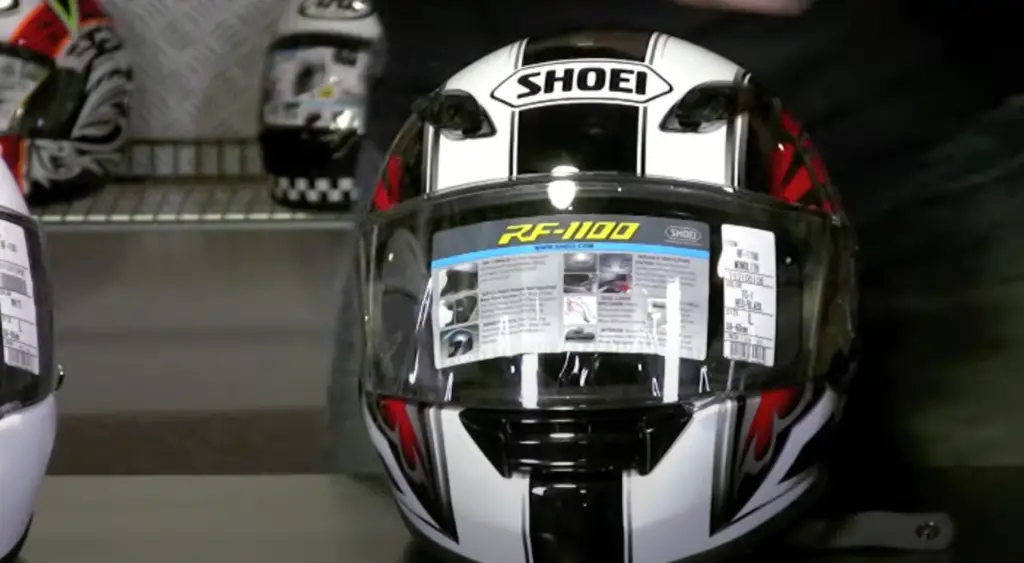
Another important aspect of motorcycle helmets is that they are made to protect your head in an accident. This means that they are usually made from strong materials like Kevlar or carbon fiber. They should also have a thick layer of padding on the inside to absorb impact and protect your head from being injured.
Finally, you should make sure that your helmet has good ventilation. This will help to keep you cool in hot weather and prevent fogging up your visor. Good ventilation will also help to reduce wind noise while you are riding.
Outer Shell
The outer shell of the safest motorcycle helmet is usually made from a variety of materials. The most common material is polycarbonate, which is a type of plastic. This material is lightweight and strong, making it ideal for motorcycle helmets. Other materials used in the construction of motorcycle helmets include fiberglass, Kevlar, and carbon fiber.
Fiberglass and Kevlar are both more flexible than polycarbonate, but they are also heavier. Carbon fiber is the strongest and lightest of all the materials used in helmets, but it is also the most expensive.The outer shell should be thick enough to protect your head from impact in an accident. It should also be able to flex and absorb energy in an impact. The thickness of the outer shell will vary depending on the material it is made from. Polycarbonate shells are usually about three millimeters thick, while Kevlar and carbon fiber shells can be up to six millimeters thick.
Impact Absorbing Liner
The impact absorbing liner is the second layer of the safest motorcycle helmet. This layer is designed to absorb the energy from an impact and spread it out over a larger area. The most common material used in the construction of an impact absorbing liner is EPS, or expanded polystyrene. This material is lightweight and has a good ability to absorb energy. Other materials used in the construction of an impact absorbing liner include polyurethane and gel.
EPS is lightweight and has a good ability to absorb energy. However, it can compress under extreme force, which can cause your head to be pushed forward in an accident. Polyurethane and gel are both more flexible than EPS, but they are also heavier.
EPS liners are usually about ten millimeters thick, while polyurethane and gel liners can be up to fifteen millimeters thick.
Padded Comfort Layer
It is designed to provide cushioning and comfort for your head. The material used is polyester foam. Other materials used in the construction of a padded comfort layer include EVA foam and gel.
Polyester foam is a very popular choice because it is lightweight and has a good ability to absorb impact. However, it can compress under extreme force, which can cause your head to be pushed forward in an accident. EVA foam and gel are both more flexible than polyester foam, but they are also heavier.
Retention System/Chin Strap
The retention system, or chin strap, is the fourth layer of the safest motorcycle helmet. This layer is designed to keep the helmet securely on your head in an accident. The most common type of retention system is a D-ring. This type of retention system has a metal D-ring that fits over your head and under your chin. Other types of retention systems include ratchet straps and magnetic closures.
D-rings are the most popular type of retention system because they are easy to use and adjust. However, they can come loose in an accident if not properly secured. Ratchet straps are more secure than D-rings, but they can be difficult to adjust while you are wearing the helmet. Magnetic closures are the easiest type of retention system to use, but they are not as secure as D-rings or ratchet straps.
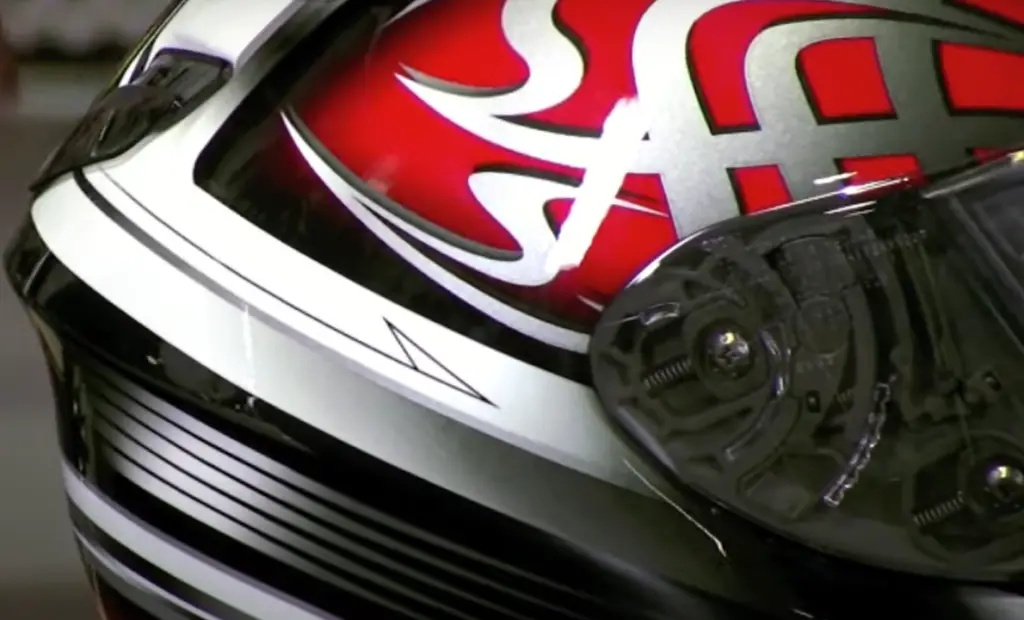
The chin strap of the safest motorcycle helmet should be made from a sturdy material that will not break in an accident. The most common materials used for the construction of a chin strap are nylon and polyester. Nylon is stronger than polyester, but it can stretch in an impact. Polyester is less likely to stretch than nylon, but it is not as strong.
The thickness of the chin strap will vary depending on the material it is made from. Nylon straps are usually about two millimeters thick, while polyester straps can be up to four millimeters thick.
Vents
The final layer of the safest motorcycle helmet is the vents. Vents are designed to keep your head cool in hot weather and to allow air to circulate around your head in an accident. The most common type of vent is a mesh vent. This type of vent has a small hole that is covered by a mesh screen. Other types of vents include slits and louvers.
Mesh vents are the most popular type of vent because they allow air to circulate freely around your head. However, they can also let in dirt and debris. Slits and louvers are less likely to let in dirt and debris, but they do not allow as much air to circulate around your head.
The number of vents on a motorcycle helmet will vary depending on the model. Some helmets have no vents, while others can have up to twenty vents.
Face Shield/Visor
The final layer of the safest motorcycle helmet is the face shield or visor. The face shield is designed to protect your eyes from the sun, wind, and debris. It is also designed to shatter in an accident so that it does not injure your face. The most common type of face shield is a clear polycarbonate shield. Other types of shields include tinted shields and mirrored shields.
A clear polycarbonate shield is the most popular type of face shield because it allows you to see clearly while riding. However, it can also be easily scratched and cracked. A tinted shield can help reduce glare from the sun, but it can also make it difficult to see at night. A mirrored shield can help reduce glare from the sun and can also make it difficult to see at night.
The thickness of the face shield will vary depending on the type of helmet it is attached to. A full-face helmet will have a thicker face shield than a half-face helmet.
Most motorcycle helmets come with a clear polycarbonate face shield. However, some models come with tinted or mirrored shields. You can also buy aftermarket shields for your motorcycle helmet.
Tinted and mirrored shields are designed to reduce glare from the sun. However, they can also make it difficult to see at night. If you ride in low light conditions, you should consider buying a clear shield or an aftermarket visor with an anti-fog coating.
Cheek Pads
The final layer of the safest motorcycle helmet is the cheek pads. Cheek pads are designed to cushion your face in an impact and to prevent your helmet from moving around on your head. The most common type of cheek pad is made from foam. Other types of cheek pads include gel and airbags.
Foam cheek pads are the most popular type of cheek pad because they are comfortable and easy to replace. However, they can compress in an accident and may not provide as much protection as other types of pads. Gel cheek pads are more expensive than foam pads, but they offer better protection in an accident. Airbag cheek pads are the most expensive type of pad, but they offer the best protection in an accident.
How to Choose the Right Size Motorcycle Helmet
It’s important to choose a motorcycle helmet that fits properly. A too-big helmet can come off in a crash, and a too-small helmet won’t protect your head properly. To find the right size, first measure your head circumference. Then try on several different helmets until you find one that fits snugly but isn’t too tight. [3]
The Shoei RF-1100 helmet comes in a variety of sizes, so you’re sure to find one that fits you well. Once you’ve found the right size, it’s time to choose the right model.
Shoei RF-1100
Paint, Graphics and Overall Quality
The Shoei RF-1100 is a beautifully designed helmet. It’s sleek, it’s stylish and it looks expensive. But what about the quality?
When you first hold the RF-1100 in your hands, you can feel the weight of the helmet. It’s not too heavy, but it’s definitely not lightweight either. The overall quality of the materials used is very good. The helmet feels solid and well put together.
The paint job on the RF-1100 is excellent. The graphics are sharp and vibrant. There are no imperfections that I can see.
Shoei has done an excellent job with the design and quality of the RF-1100 helmet. It’s a beautiful piece of equipment that should last you for years to come.

The only downside of the RF-1100 is the price. At $550, it’s one of the most expensive helmets on the market. But if you’re looking for a top-of-the-line helmet, the RF-1100 is definitely worth the investment.
Helmet Fit, Comfort and Internal Shape
It is extremely comfortable. The padding is soft and plush, and the straps are adjustable so you can get the perfect fit.
The internal shape of the RF-1100 is designed to fit a wide variety of head shapes. I have a fairly round head, and the helmet felt great. There were no pressure points or hot spots.
The helmet has a nice, wide field of vision. The eye port is large and the visor is easy to remove and replace.
Helmet Weight
That’s about average for a full-face helmet.As far as aerodynamics go, the RF-1100 is very good. Its sleek and stylish design cuts through the air with ease. And even at high speeds, the helmet is stable and doesn’t buffet or shake.
Noise Levels
The RF-1100 is a very quiet helmet. Even at high speeds, the wind noise is minimal. And when you’re riding in city traffic, the helmet does an excellent job of blocking out engine and road noise.
Ventilation
The RF-1100 has great ventilation. The front chin vent and top vents can be opened and closed with gloves on. And when the vents are open, the helmet gets a nice flow of air.
Face Shield
The face shield is excellent. It’s easy to remove and replace, and it has a nice, wide field of vision. The helmet also comes with a tinted visor for those sunny days.
FAQ
Is AGV better than Shoei?
It’s tough to say which brand is “better.” Both brands have their pros and cons. However, many riders feel that AGV helmets offer better overall protection, while Shoei helmets tend to be more comfortable. [4]
Why are Shoei helmets so good?
Shoei helmets are consistently rated highly for safety and their sleek designs. They offer a wide variety of features that are designed to provide riders with the best possible experience.
One of the most popular features of Shoei helmets is the Emergency Quick Release System (EQRS). It allows riders to quickly and easily remove their helmet in the event of an accident.
Shoei also offers a wide variety of visors and shield options that can be used to customize the look of your helmet. These options allow you to choose the perfect level of protection and style for your needs. [5]
Shoei helmets are also known for their comfort. Their helmets are lined with soft, comfortable materials that make them ideal for long rides.
Is Shoei a Japanese brand?
Shoei is a Japanese company that has been making motorcycle helmets since 1959. In 1975, Shoei released its first full-face helmet, the RF-100. The RF in the name stands for “racing full face.” The 100 signifies that it was the company’s 100th product.[6]
Since then, Shoei has released several different versions of the RF series helmet.
Is Shoei RF-1200 Snell rated?
The RF1200 retains its SNELL M2010 safety classification.
Is Shoei RF-1100 quiet?
The Shoei RF-1100 is not a quiet helmet. It is rated 3 out of 5 for noise control.
If you’re looking for a quiet helmet, the Shoei RF-1100 may not be the best option. It’s rated 3 out of 5 for noise control, so you may want to consider other options if noise reduction is a top priority. However, the helmet does have some features that could help to reduce noise levels, such as ear pockets that are designed to reduce wind noise. Additionally, the helmet’s visor is fog-resistant and provides good visibility, which could also help to reduce distractions and noise levels while riding. Overall, the Shoei RF-1100 is not a quiet helmet, but it does have some features that could help to reduce noise while riding.
When did Shoei stop making the RF-1100?
The Shoei RF-1100 was discontinued in 2017. It was replaced by the Shoei RF-1200.
If you’re looking for an RF-1100, you’ll need to find one from a used helmet dealer or online marketplace. The helmet was discontinued in 2017 and replaced by the Shoei RF-1200. While the RF-1100 is no longer in production, it’s still a popular choice among riders due to its quality construction and features. If you can find an RF-1100 in good condition, it’s sure to provide years of safe and comfortable riding.
Do Shoei helmets expire?
Shoei helmets do not have an expiration date, but they do have a 5-year warranty.
Shoei helmets are designed to last for many years, but the company does recommend replacing them every five years. This is because the materials and construction of the helmet can degrade over time, which could impact its safety and performance. Additionally, Shoei recommends that riders have their helmets professionally inspected every two years to ensure that they are in good condition. If you take care of your Shoei helmet, it should provide years of safe and comfortable riding.
How long can you use a Shoei RF-1100 helmet?
The average lifespan of a Shoei RF-1100 helmet is about five years. However, this may vary depending on how often you use the helmet and how well you take care of it. It is important to follow the care instructions that come with your helmet to help extend its lifespan. Additionally, regular inspection and maintenance can help ensure that your helmet remains in good condition and safe to use. If you have any concerns about the condition of your helmet, it is best to consult with a qualified technician or dealer for advice.
Why do people love the Shoei RF-1100 helmet?
There are many reasons why riders choose the Shoei RF-1100 helmet. Its sleek design and comfortable fit are two of the most popular reasons. Additionally, the RF-1100 comes equipped with superior anti-fogging and ventilation features, making it an ideal choice for those who ride in all types of weather conditions. And finally, riders appreciate the helmet’s high level of safety, which is achieved through its advanced shell construction and impact-absorbent liner. All of these factors combine to make the Shoei RF-1100 one of the most popular motorcycle helmets on the market today.
What are some of the features that make the Shoei RF-1100 helmet so popular?
The Shoei RF-1100 is a popular helmet for a number of reasons. First, it features a sleek and aerodynamic design that helps reduce wind noise and drag. Additionally, the helmet has a wide field of vision, thanks to its large eye port, and comes equipped with an integrated sun visor. The helmet is also comfortable to wear, thanks to its padded liner and chin strap, and is available in a variety of sizes to fit most riders. Finally, the Shoei RF-1100 is DOT-approved and comes with a five-year warranty.
How does the RF-1100 compare to other helmets on the market?
The RF-1100 is one of the most popular helmets on the market for a reason. It’s packed with features that riders love, like an integrated sun visor, aero-tuned ventilation system, and a super stable fit. Plus, it looks great too! When it comes to safety, the RF-1100 meets or exceeds DOT and ECE 22.05 standards, so you can rest assured knowing that you’re well protected. As far as comfort goes, the RF-1100 has plenty of it. The interior is lined with soft, plush fabric that feels great against your skin, and the helmet includes a set of removable ear pads to help block out noise. All in all, the RF-1100 is an excellent choice for any rider looking for a high-quality, feature-rich helmet.
Is the RF-1100 helmet worth the price tag?
If you’re looking for a helmet that offers great protection, the RF-1100 is definitely worth considering. This helmet is loaded with features that are designed to keep you safe on the road, and it’s one of the most comfortable models on the market. However, it is important to keep in mind that the RF-1100 is a bit more expensive than some of the other options out there. But if safety is your top priority, this helmet is definitely worth the investment.
Related Video: Shoei RF-1100 Helmet Review at RevZilla.com
Conclusion
After reading this guide, hopefully, you now have a better understanding of the Shoei RF-1100 helmet. This is an excellent helmet that offers great protection and comfort. If you’re in the market for a new helmet, the Shoei RF-1100 should definitely be at the top of your list. Thanks for reading!
References:
- https://www.motorcyclelegalfoundation.com/types-of-motorcycle-helmets/
- https://www.compliancegate.com/helmet-safety-standards-united-states/
- https://www.motosport.com/blog/motorcycle-helmet-size-guide-how-to-measure-fit-the-right-helmet
- https://theridesofar.com/2020/05/agv-k6-versus-shoei-rf-1200-is-there-a-new-standard-in-motorcycle-helmets/
- https://www.motorcyclegear101.com/helmets/shoei-helmets-worth-the-money/
- https://shoei-helmets.com/production-quality-assurance/

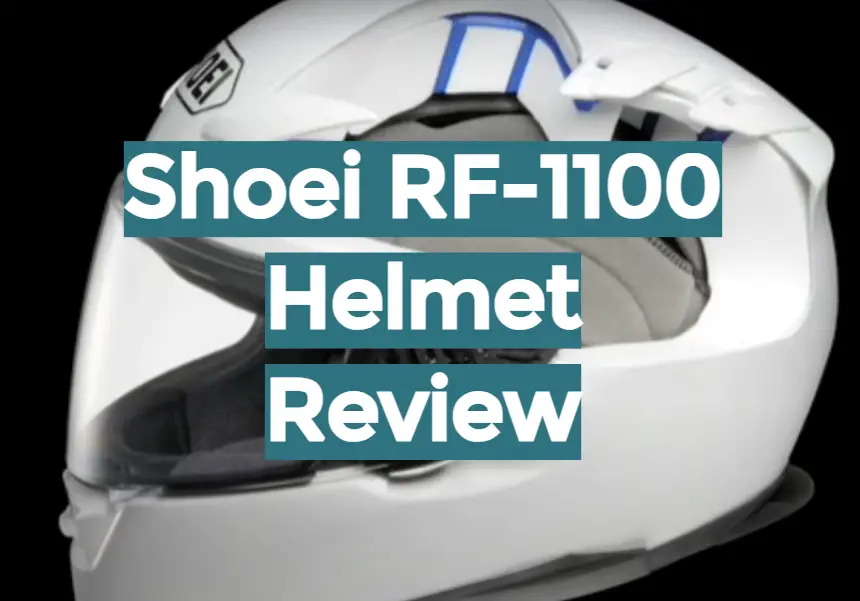

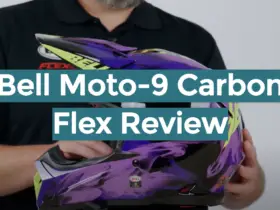
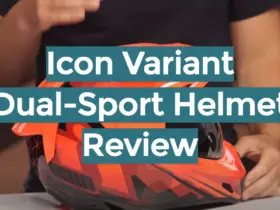

Leave a Reply